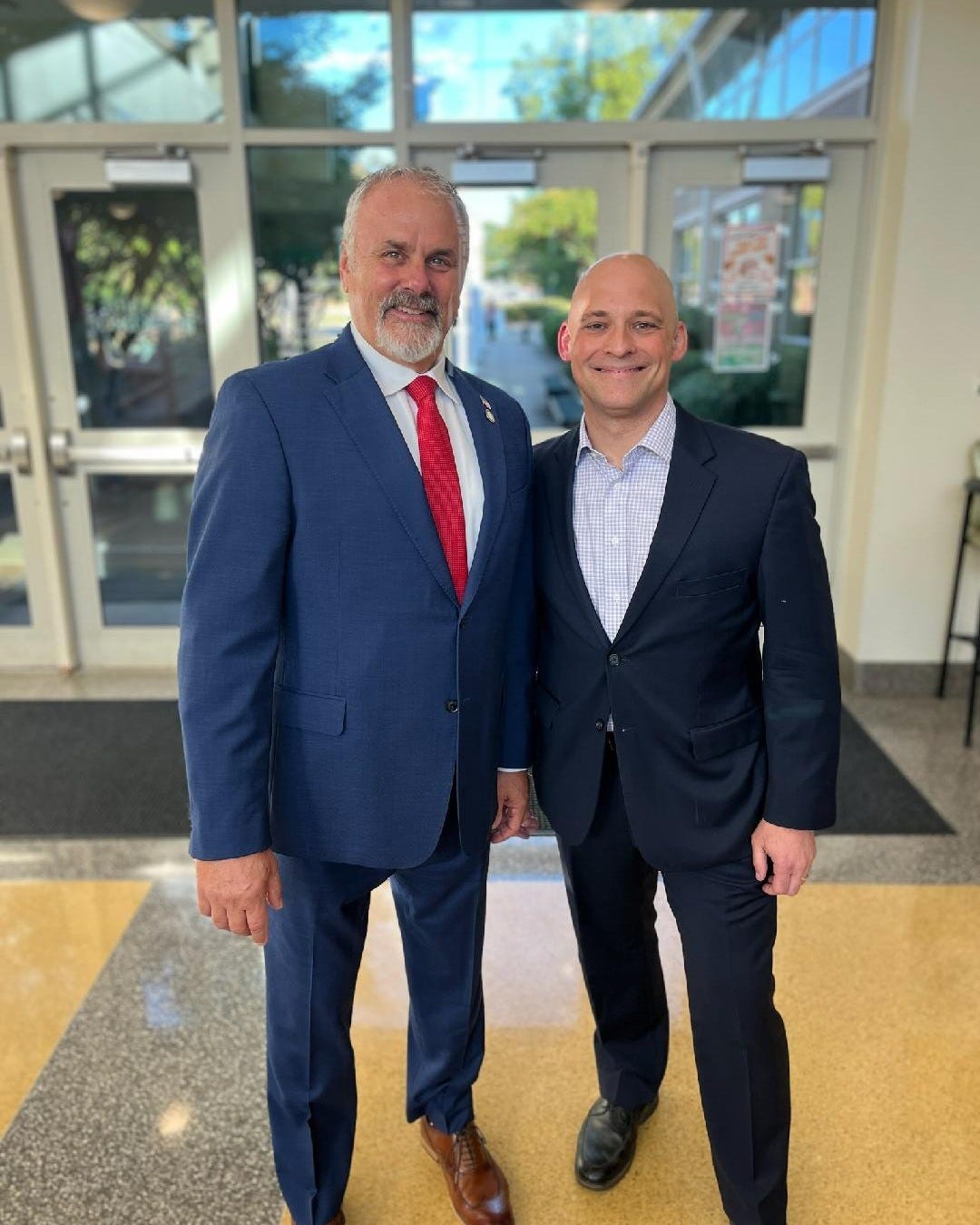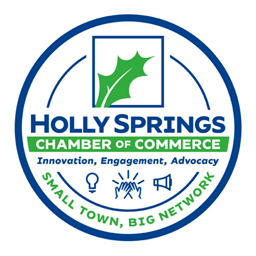Publisher Observations: Holly Springs' Mayoral Candidates Forum Highlights Key Differences
Traffic, growth, housing, and small business dominated the Chamber of Commerce's Mayoral Forum as incumbent Sean Mayefskie and challenger Mike Kondratick outlined their approaches to town priorities.

Note to readers: This story is based on the observations of Holly Springs Update publisher’s observation and thoughts from the video and transcript from the Mayoral Candidate Forum. Readers are encouraged to visit each candidate’s website, watch the forum video on the Chamber’s YouTube channel, and take advantage of upcoming in-person opportunities to hear directly from the candidates before casting a ballot in the November 4th non-partisan municipal election.
Holly Springs, NC, Sep. 23, 2025 — The Holly Springs Chamber of Commerce (website) hosted the Mayoral Candidate Forum this past Thursday at the Holly Springs Cultural Center, offering residents a chance to hear directly from incumbent Mayor Sean Mayefskie (website) and challenger Mike Kondratick (website).
The moderated forum followed a structured format, with equal time allocated to each candidate: three-minute opening statements, 90-second responses to resident-submitted questions, optional rebuttals, and three-minute closing remarks. Questions were finalized by the Chamber’s Government Relations Committee shortly before the event began.
The forum covered issues including traffic, transportation, housing, small business, the arts, and diversity. While both candidates emphasized growth management and community priorities, their responses revealed differences in emphasis and approach.
Opening Statements
Mike Kondratick opened by framing his candidacy around listening and responsiveness, emphasizing the thousands of conversations he has had with residents during his campaign. He said Holly Springs needs a leader focused on transparency, inclusivity, and ensuring that development and policy decisions prioritize the needs of residents first.
Sean Mayefskie followed by thanking residents and highlighting Holly Springs’ growth during his tenure. He underscored his experience as mayor and pointed to regional partnerships that have helped secure infrastructure funding, stating that his leadership ensures the town is well-positioned for continued success while maintaining low taxes.
Questions Posed and Answers
Q1
“Our first question since you introduced first we’ll go to you for the first question. You’ll both have the same question. Sean what do you see as the most critical challenge facing our community today and how have you engaged with town staff or residents around this issue to make sure you fully understand its complexity.”
Mayefskie called traffic the “obvious” challenge and cited the Northeast Gateway project as a step forward. He explained that his engagement with the issue includes working closely with staff and regional agencies, such as CAMPO, where Holly Springs has secured significant road funding, and meeting directly with business owners whose growth is constrained by infrastructure limitations.
Kondratick also identified traffic but tied it directly to rapid development, saying residents feel growth is happening “to them and not for them.” He stressed that his engagement stems from thousands of conversations with residents during his campaign, where he has consistently heard concerns about developments such as Easton Acres that were approved despite traffic concerns, giving him a firsthand understanding of how people experience congestion daily.
Q2
“… How do you feel about current transportation options… Are they affordable and accessible to all and if not what would you do.”
Kondratick said Holly Springs underinvested in microtransit, arguing that earlier action taken by the town could have alleviated congestion. He emphasized the importance of allocating more resources to transit now to ensure that options are affordable and accessible for all residents.
Mayefskie described his outreach to Raleigh Mayor Mary-Ann Baldwin to learn about their model, which directly informed the creation of the recently approved Holly Springs Hopper transit service. He said this service demonstrates how regional cooperation can yield tangible benefits for town residents.
Publisher’s Note: Neither candidate directly addressed the part of the question asking how they feel about current transportation options or whether they are currently affordable and accessible. Instead, both reframed their answers — Kondratick focusing on missed investment opportunities and Mayefskie highlighting accomplishments.
Q3
“… many people say that road improvements have not kept up with growth… How can you ensure Holly Springs will keep up with that demand.”
Mayefskie emphasized that development is what secures state funding, noting he helped bring $236 million in CAMPO funds to Holly Springs. He stated that growth is not the enemy, but rather the vehicle for needed infrastructure investment.
Kondratick countered that developer-driven planning is the root of today’s congestion problems. He suggested Holly Springs should consider tools like transportation bonds, pointing to Apex’s example as a model that could help the town fund road improvements more effectively.
Publisher’s Note: Both candidates referenced funding mechanisms but stopped short of explaining concrete steps for ensuring Holly Springs can keep up with road demand. Mayefskie leaned on past funding wins, while Kondratick cited Apex’s bond approach without detailing how it would be applied locally.
Q4
“How do you feel about partisan politics being a part of local elections and how will you work on issues with council members that do not share your position on issues that may be partisan in nature.”
Kondratick said residents’ issues, like water quality or neighborhood speeding,aren’t partisan, and that voters expect council members to solve problems collaboratively. He called for more debate and transparency in council meetings so disagreements can be worked out in public.
Mayefskie downplayed partisanship at the municipal level, saying constituents call him about “a dead deer in the road” rather than political ideology. He noted that as a council member, he broke tie votes both with and against Republicans, showing he can work across lines.
Publisher’s Note: Neither candidate explicitly explained how they would work with council members who do not share their position. Both used the question to minimize partisanship at the local level rather than outline strategies for collaboration across differences.
Q5
“How do you plan to ensure small businesses have the opportunity to build and expand in Holly Springs.”
Mayefskie highlighted examples, such as Fujifilm Diosynth’s decision to hire a local coffee shop vendor, as proof that partnerships work. He also emphasized the shortage of flex space for trades such as plumbing and HVAC, stating that the town must find ways to accommodate these businesses.
Kondratick proposed several concrete steps to ease costs and create opportunities for local entrepreneurs. These initiatives included expanding the downtown development grant program, forming purchasing cooperatives, and establishing student internship programs to strengthen workforce pipelines.
Publisher’s Note: The question asked how candidates would ensure opportunities for small businesses. Both offered examples or ideas, but neither described a mechanism by which opportunities could be guaranteed across the community.
Q6
“The creative arts are essential drivers of economic vitality, social connection, and quality of life. Do you support town investments in the arts sector and how would you work to support and enhance the arts as part of your economic development policies.”
Kondratick endorsed expanding cultural investment through a Wake County library bond, developing a regional performing arts center, and launching a town-run arts grant program. He said the arts are key drivers of quality of life and economic development.
Mayefskie pointed to his personal idea for a mural on the old police station and highlighted existing dance and music programs. He said the arts play an essential role in keeping the community connected and celebrating Holly Springs’ 150th anniversary.
Q7
“As someone with equal power as other council members how would you approach decision making and foster collaboration.”
Mayefskie said he calls council members before meetings to answer questions and reduce surprises, arguing that collaboration often happens before meetings, not during them. He said this practice ensures smoother public sessions and avoids unnecessary “aha moments.”
Kondratick said listening is the most compelling form of leadership. He pointed to his campaign’s thousands of one-on-one conversations with residents as an example of how he would bring consistency and inclusiveness into decision-making.
Publisher’s Note: Both spoke about communication styles, but neither gave specific examples of how they would handle disagreements among council members once in office.
Q8
“What areas of improvement do you think the town should focus on.”
Kondratick emphasized the need for greater transparency in PFAS water testing and more reliable communication with residents. He also argued that workforce housing and nondiscrimination policies are overdue, stating that Holly Springs needs to do more to ensure both affordability and inclusion as the town expands.
Mayefskie criticized the town’s procurement process, saying it defaults to “three bids, low bid wins.” He also reiterated that the town’s role in housing is limited to utilities and regional partnerships, not direct policy intervention.
Q9
“Are you for or against the proposed 250 megawatt data center being located in our area.”
Mayefskie said the project has not yet come before the town council or planning staff, so it would be premature to decide. He stressed the importance of reviewing data and impacts before making any commitments.
Kondratick pointed to the proposed Harris Lake location and said environmental concerns are significant. He argued that without clear benefits for Holly Springs, it is difficult to support such a project.
Q10
“Do you think that the town should be pushing tourism in our community.”
Kondratick supported tourism as part of the town’s economic development strategy. He argued that while Holly Springs already attracts regional visitors, more should be done to diversify its economic base.
Mayefskie said Holly Springs already benefits from tourism through sports tournaments, Eagles Landing Park’s grant funding, and ESPN’s broadcast of women’s professional softball at Ting Park. He described these as proof that the town is becoming a recognized regional destination.
Q11
“Do you believe the current committee selection process is fair and balanced… If not what changes would you suggest.”
Mayefskie said the existing system, where council members vote on applicants, is fair and appropriate. He emphasized that the town council has a responsibility to pick the people it believes are most qualified.
Kondratick stated the town boards do not reflect the full diversity of the community. He called for greater outreach to underrepresented groups to expand participation.
Closing Statements
Sean Mayefskie delivered his closing statement first. He highlighted Holly Springs’ strong record of economic growth, low taxes, and successful partnerships with regional and state organizations. He told residents that his experience and proven ability to secure infrastructure funding position the town for continued progress and stability.
Mike Kondratick followed with his closing remarks, returning to the theme of listening and transparency. He said Holly Springs needs leadership that puts residents’ voices at the center of decisions, arguing that his approach would ensure development, infrastructure, and policy choices are made for the benefit of the entire community.
Candidate Response Consensus and Divergence
Broad Consensus
Both agreed that traffic is the top challenge facing Holly Springs.
Both supported the arts as an essential community investment.
Both said more information is needed before deciding on the proposed data center.
Points of Divergence
Traffic Solutions: Mayefskie emphasized the need to leverage development to secure CAMPO funding, while Kondratick stated that reliance on developers has worsened congestion.
Small Business: Mayefskie focused on flex space and partnerships, while Kondratick stressed cost relief and co-ops.
Housing & Inclusion: Kondratick argued that workforce housing and nondiscrimination policies are overdue, while Mayefskie said the town’s role is limited to utilities and partnerships.
Governance: Mayefskie leaned on behind-the-scenes communication with the council, while Kondratick prioritized debate and transparency during meetings.
Forum Recap
The Mayoral Forum showcased two contrasting styles: Mayefskie leaned on past achievements, regional partnerships, and infrastructure projects, while Kondratick emphasized listening, transparency, and new policy initiatives. Their answers revealed agreement on core challenges like traffic and arts investment, but sharp differences in how each would address them.
Note: The Chamber of Commerce has posted a recording of the forum to its YouTube channel, and the 2025 Holly Springs Voters’ Guide is available online (link).


As a fairly new resident I value this reporting. The presentation is fair and balanced. A rarity these days.